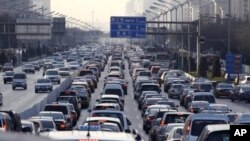Ask anyone anywhere in the world about their daily commute to work or school, and you will likely hear horror stories. But, according to the 2011 Commuter Pain Index, technology may be providing a happy ending.
Do you get angry when you drive? How is that affecting your performance at school or at your house? Do you actually give up and turn around and just go home? How long are you in traffic?
These are the types of the questions asked to over 8,000 commuters in 20 global cities.
Vinodh Swaminathan, is an intelligent transportation systems expert at IBM, which conducts the annual survey. He says it is an attempt to understand commuting dynamics and drivers’ attitudes around the world. This year, he says, there is still plenty of commuting pain, especially in emerging economies.
Commuting pain
“Some of the cities where citizens indicate a lot of frustration and a lot of pain were in the emerging economies, cities like New Delhi, Bangalore, Beijing and Mexico City,” says Swaminathan.
Drivers in those cities spend the most time on the road getting to work or school. But Swaminathan notes that local officials are trying to do something about congestion.
“There are many more ring roads built in Beijing today," he says. "Mexico City plans to invest $2.5 billion dollars to address some of the infrastructure issues they have.”
He says the survey found that traffic congestion has decreased in many parts of the world due to the recession, which slowed economic activity and boosted the price of gas. Drivers questioned in Stockholm, Singapore, Madrid and Buenos Aires reported spending less than 30 minutes or even no time stuck in traffic.
Taking public transportation
The survey results also reflect an increased willingness to use public transportation. Forty one percent of commuters globally said improved bus and rail service would help reduce stress. Swaminathan points to the Swedish capital, Stockholm, as one city which implemented that suggestion.
“One of the things that they did a couple of years ago is significantly increased the amount of public transportation capacity and simultaneously developed a congestion pricing system that IBM helped them implement," he explains. "It automatically imposes a fee for people who travel to downtown Stockholm during rush hours. It encouraged a lot of people to move to public transportation.”
And, he adds, changing the commuting pattern helped improve not just traffic, but the quality of life.
“It actually made people buy more green cars because green cars were exempt from this congestion fee," he says. "So, traffic was reduced by 25 percent during rush hour in downtown Stockholm. The carbon emissions were reduced by 25 percent in downtown Stockholm. Public transit useage actually increased by 50 percent. And because of the reduced traffic, buses in Stockholm, their timetables were adjusted because they were moving a lot faster through the city.”
Intelligent solutions
Many cities in emerging economies are moving in similar directions to alleviate traffic pain. Brian Cotton is vice president of a consulting firm that helps provide intelligent solutions.
“One of the cities that I like to point to is Shenzhen in Southern China," Cotton says. "It's a huge mega metropolitan area.
Shenzhen has also been investing in constructing infrastructure, not just roadways, but also a pretty robust public transportation system to help move people in and around the city.”
Cotton says technology can help alleviate traffic congestion.
“The first step on the path is to collect data," he adds. "Being able to provide information to the commuters is the next step. Giving travelers information in the form of digital signage that goes up above the roadways, the information systems that are built in automobiles themselves, even on smart phones.”
Smart Traveler Program
That is how IBM’s Smart Traveler Program works. Vinodh Swaminathan says it’s being used in the San Francisco Bay Area to allow commuters to decide the best route, before they hit the road.
“We study your general travel patterns and your commuting patterns on an everyday basis," he explains. "What we then do is use the predictive technology to understand what’s likely to happen in the normal routes that you take. Then we proactively inform you up to 60 minutes ahead of time on what’s likely to happen on your travel route. It’s the equivalent of telling you it’s going to rain; you need to take an umbrella.”
This is the fourth year IBM has conducted the Commuter Pain survey.







